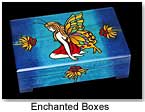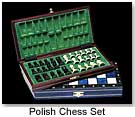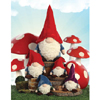|
|
Secrets of Success Inside the Enchanted World of Boxes
"We started by selling crafts at local street fairs, then we joined the New York Gift Show and all other gift shows in the United States," Kowalski told TDmonthly Magazine. In 1992, they began to design their own products and, in 1996, Venezuelan artist Tony Cortez joined the company to help with this task. Although many boxes are still crafted by independent artists in Poland ’s Tatra Mountains, others are constructed in the company’s small Polish factory, which was built in 2003. Just this year, Enchanted World entered a joint venture with China. Yet, the United States remains its biggest market.
Targeting the female demographic, they have products for every age group. "We like to make boxes for children, teenagers, adults and every ethnic and religious group." Card, executive desk and jewelry boxes are made for the adult market, and styles for children include tooth-fairy boxes and animals, along with pirate boxes with locks and pencil holders with mermaids and frogs. They now sell fairy boxes with inexpensive fairy dolls. For teenagers, sun, moon and butterfly designs are popular. "These items are very popular in children's stores. There is nobody really selling things like this since most products for children on the market are mass produced," Kowalski said.
The company sells wholesale to retailers willing to place a minimum opening order for $175. They also offer unfinished boxes to craftsmen who meet the minimum order requirement. Any individual can place a custom order for 200 pieces. "Boxes are a dying tradition in Poland," Kowalski explained. "Work is very labor intensive. Polish boxes are really a disappearing art." Outside of scarcity, what makes them unique? "We are artists. Innovation in design, color and idea is what sets us apart from others,” he replied. Writer's Bio: Julia Ann Charpentier is a Milwaukee-based freelance writer and an editor for book publishers. Read more articles by this author
|
| |||||||||||||||||||||||||||||||||
Disclaimer Privacy Policy Career Opportunities
Use of this site constitutes acceptance of our Terms of Use.
© Copyright 2025 PlayZak®, a division of ToyDirectory.com®, Inc.

 The founders — Teresa Witkowska, who held a Master of Fine Arts degree in painting from the University of Fine Art in Krakow, and Christopher Kowalski, who at the time was a Ph.D. student studying social anthropology and the history of religion at Harvard — had not intended on global expansion. That came later.
The founders — Teresa Witkowska, who held a Master of Fine Arts degree in painting from the University of Fine Art in Krakow, and Christopher Kowalski, who at the time was a Ph.D. student studying social anthropology and the history of religion at Harvard — had not intended on global expansion. That came later.  Though the company makes expansion look easy, Kowalski remarked, "In the beginning, everything is always difficult."
Though the company makes expansion look easy, Kowalski remarked, "In the beginning, everything is always difficult."  Their exclusive Secret Boxes contain compartments. "We make new ones every year. It is intense. One needs a lot of energy and imagination to move above commodity and to create art for sale."
Their exclusive Secret Boxes contain compartments. "We make new ones every year. It is intense. One needs a lot of energy and imagination to move above commodity and to create art for sale."

